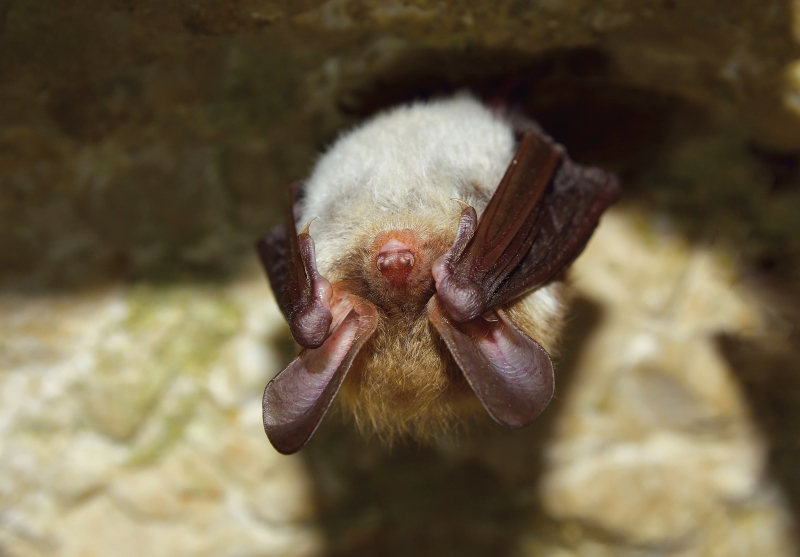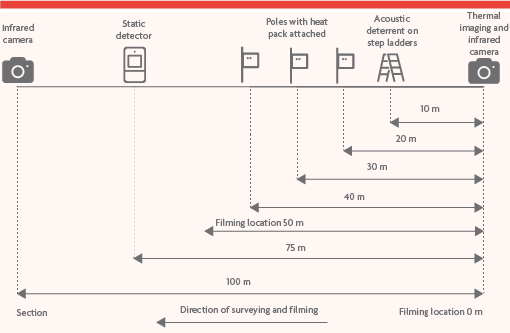environmental SCIENTIST | The search for tranquility | October 2019
Nigel Burton explains the way that sound is used to increase bat safety around large infrastructure projects.
High Speed 2 (HS2) is a high-speed railway that is planned to run between London and Birmingham (Phase 1) and then from Birmingham to Manchester and Leeds (Phase 2). A section of the route planned for Phase 1 lies across well-used Bechstein’s bat flightlines between fragmented ancient woodlands in North Buckinghamshire. This means that the railway could disrupt the movement of bats between roosts and foraging areas, with adverse effects on their conservation status.
Bats have sensitive and highly evolved acoustic apparatus and this, coupled with their complex habitat requirements and wide-ranging use of landscapes, means that they are vulnerable to disturbance, habitat fragmentation and death or injury caused by a wide range of development projects. Bechstein’s bats (see Figure 1) are of particular importance as one of the UK’s rarest and most endangered species, with some estimates that no more than 1,000 individuals exist in the whole of the UK. Added to which this specific population of 200–300 individuals is the most northerly in Europe and therefore of significant genetic value.
 |
| Figure 1. A Bechstein's Bat. (© Adi Ciurea | Adobe Stock) |
The challenge
A variety of mitigation options were investigated to address the risk of bats colliding with trains as they fly the 800 m long western boundary of Sheephouse Wood, a site of special scientific interest (SSSI), which abuts HS2. The construction of a conventional tunnel or the use of lighting were rejected for logistical feasibility or safety reasons. The solution chosen was to provide an 800 m long mesh structure over the railway to direct bats to safely fly up and over the train line. However, there was the potential risk that bats would fly into either end of this structure and then be unable to avoid oncoming trains. Therefore appropriate mitigation measures were required not only to achieve consent from Natural England, which required assurances that no bat mortalities would occur as a result of the scheme, but also to avoid the risk of costly and significant delays to the building of this section of HS2.
Acoustic output, in other words, the emission of ultrasonic sounds, is increasingly being used as a way of dissuading bats from sites such as churches and windfarms – the latter pose a risk of death and injury to bats. Instead of trying to exclude bats from a whole area, the project team determined that acoustic output could be used to deter bats from a particular area, thus allowing normal bat behaviour in the vicinity to remain the same. This finding could be a better approach
to bat mitigation and be more widely used on infrastructure projects.
The Proposed Solution
Having identified potentially relevant work undertaken by the University of Bristol on the use of acoustic deterrents to relocate bats from churches, HS2 commissioned The Ecology Consultancy, BSG Ecology, the University of Bristol and Temple to work together to assess the potential for adapting existing technology for use on a high-speed rail project.
The initial objective was to determine the feasibility of using acoustic deterrents to eliminate the risk of bats entering the mitigation structure. A related issue was how to focus the deterrents so as to minimise noise spill to the surrounding sensitive habitats and the impact on public rights of way – some of these are located close to one of the proposed arrays of acoustic deterrents.
The project team needed to establish the following:
1. Were acoustic deterrents effective at deterring bats from a known flightline?
2. Over what distance and from which direction were acoustic deterrents effective?
3. What were the wider impacts of acoustic deterrents (for example on livestock, horses and pets) and did these vary under a range of environmental conditions?
4. What number and arrangement of acoustic deterrents would be required to provide effective mitigation to prevent bats from entering a mesh tunnel?
To answer questions 1 and 2, a four-week
field study was undertaken in Radstone, Northamptonshire, which involved the operation of an array of acoustic deterrents at 20 minute intervals while monitoring bat behaviour using infrared and thermal-imaging cameras (see Figure 2).
To answer question 3, a literature review was undertaken to find the reported impacts of acoustic deterrents on livestock, humans and dogs. These were backed up with incidental findings from the field study.
 |
| Figure 2. Survey setup. (Adapted from an original diagram by © Charlotte Wevill, The Ecology Consultancy) |
To answer question 4, Temple measured the volume and directivity of the sound emitted by the acoustic deterrents. Due to the ultrasonic nature of the source, this was done using a bat detector and an FFT spectrum analyser with specialist microphone in the field (see Figure 3), and supplemented with further measurements off site. Calculations were used to determine the number of acoustic deterrents required to optimise the sound level at the tunnel entrances while minimising noise spill to the wider environment.
Work was also done to manage additional constraints of undesirable noise emission beyond the ‘treated airspace’ by focusing and funnelling the noise and providing sound barriers, based on the findings of modelling the sound emitted by the acoustic deterrents (see Figure 4).
The research study was carried out under licence from Natural England to satisfy their concerns that no bat mortalities would occur.
 |
| Figure 3. The field measurement setup. (© Temple Group) |
The Findings
The following were the key findings of the research described above:
• Acoustic deterrents were highly effective at deterring bats, with a success rate of more than 98 per cent within 10 m of a unit (single acoustic deterrent);
• Testing established that the sound of the acoustic deterrents was generally emitted in a frontal
conical shape, but that sound was also emitted behind the units;
• The distance of effectiveness of the acoustic deterrents on bat behaviour was found to be up to 20 m in front and 10 m behind the units; and
• Spillage could be successfully managed, funnelled and focused using a variety of techniques including barriers, angling of the units and sympathetic landscape and structural design.
Consequently, it was concluded that bats were deterred from entering the treated airspace and that there was a distance effect of the acoustic deterrents on bats.
 |
|
Figure 4. Mixed horizontal and vertical array of acoustic deterrents arranged to optimise coverage.
(Adapted from an original diagram by © Temple Group)
|
Further Work
The team hope to continue refining this work for application on projects with costly bat mitigation (either for temporary use during construction or for permanent use). This work will seek to provide existing and new clients with cost-effective and robust solutions for bat mitigation where there is uncertainty around the effectiveness of existing methods used to maintain habitat connectivity for bats. In particular, we wish to establish whether deterrents could be used to divert bats to replacement
flightlines and potentially increase adoption of new habitat prior to clearance of existing habitat. It will also seek to align with government policy promoting a bigger, better and more joined-up natural landscape.1,2
Acknowledgements Thanks to Jon Riley and Steph Murphy of The Ecology Consultancy with acoustic input from Dani Fiumicelli at Temple.
Nigel Burton is an acoustician working on noise and acoustic issues in buildings and the environment. He is a Director at Temple, one of the UK’s leading independent infrastructure and property consultancies, specialising in environment, planning and sustainability.
@nigelnoise
References
1. Lawton, J. (Chair) (2010) Making Space for Nature: A review of England’s Wildlife Sites and Ecological Network. London: Defra.
2. Secretary of State for Environment, Food and Rural Affairs (2011) The Natural Choice: securing the value of nature. Norwich: TSO. (CM 8082)









